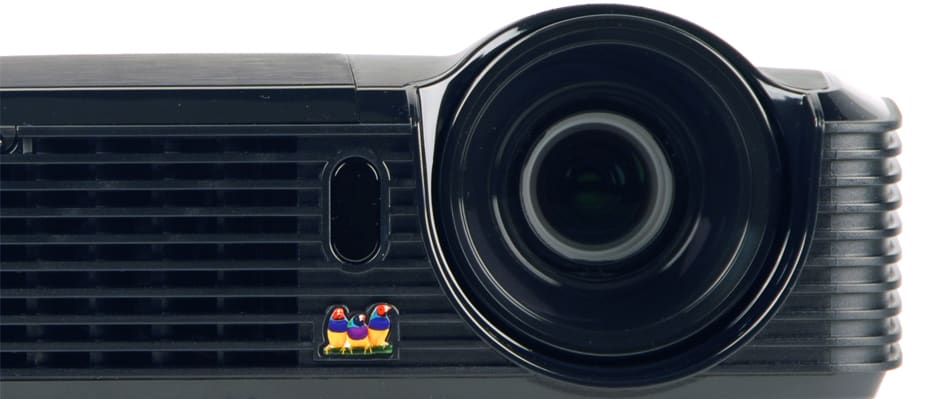Introduction
Front
{{section_header}}{{section.name}}{{/section_header}}
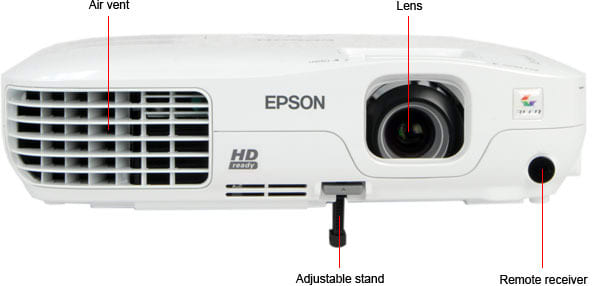
Back
{{section_header}}{{section.name}}{{/section_header}}
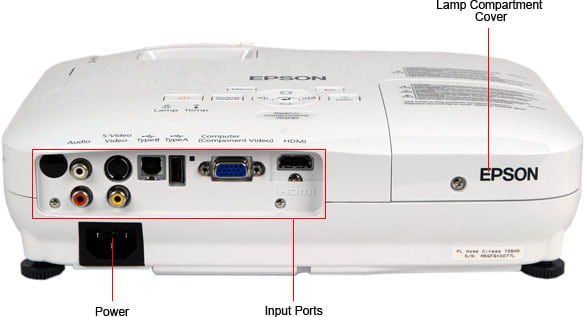
Sides
{{section_header}}{{section.name}}{{/section_header}}
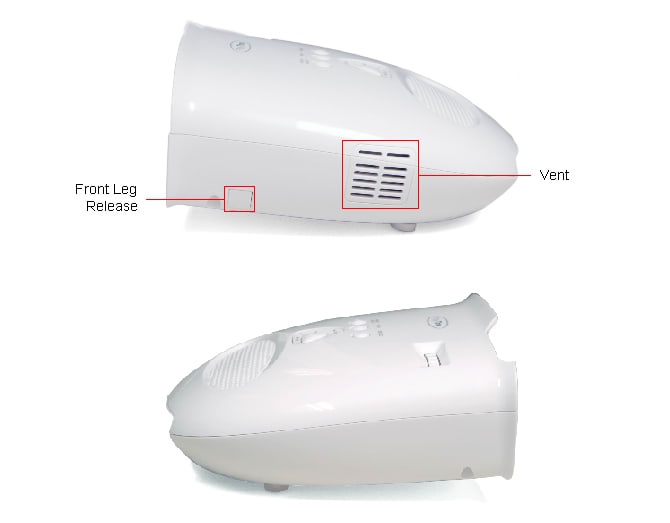
Top/Bottom
{{section_header}}{{section.name}}{{/section_header}}
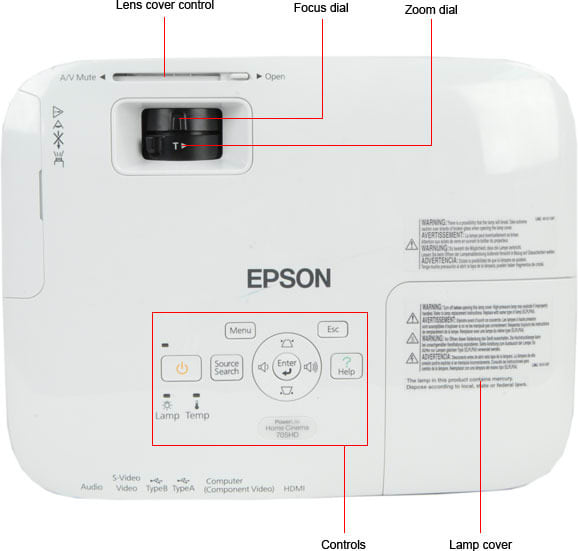
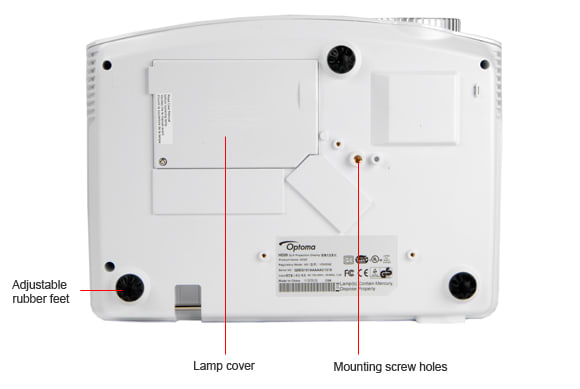
Stand/Mount
{{section_header}}{{section.name}}{{/section_header}}
A small, rubber foot at the front of the projector can be screwed up and down. There are also three screw holes for mounting it to the ceiling.
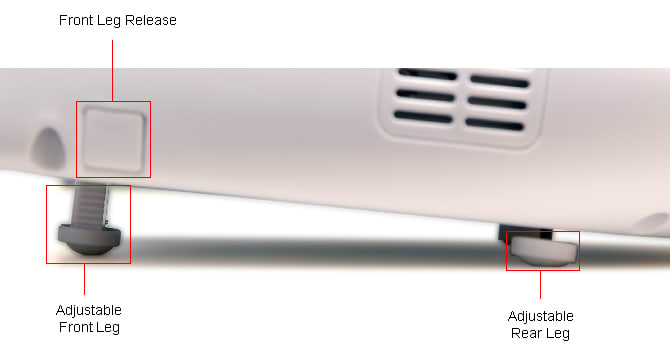
Lamp
Remote Control Tour
{{section_header}}{{section.name}}{{/section_header}}
The PJD5123's remote is very small and lightweight, as with many projector remotes. Its underside is slightly curved, so it's not too uncomfortable, overall. It looks a bit counter-intuitive at first, but the problem is largely the readability of the labels. Once you make out the tiny letters, just about everything makes sense. The mysterious, yet charmingly-labeled "My Button" can be programmed to activate a commonly-used function.
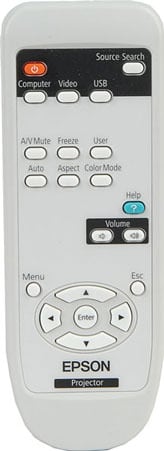
The small remote control of the 705HD
In the Box
{{section_header}}{{section.name}}{{/section_header}}
The PJD5123 is packed with a quick-start guide, a CD guide, AC cable, remote, batteries, and VGA cable. There is no lens cover or carrying case.
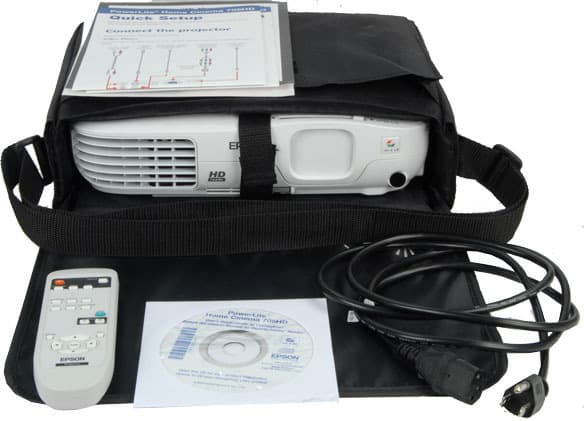
The 705HD comes with a carrying case, manuals, power cable and remote
Portability
{{section_header}}{{section.name}}{{/section_header}}
At 5.7 pounds, this projector could easily be tossed in a bag. Of course, if you want one, it'll cost you another $20. And really, if you're planning to carry around a few hundred dollars worth of equipment, you'd at least want a lens cap. Unfortunately, Viewsonic doesn't offer one, even as an accessory. So while it could easily be a portable projector, the PJD5123 is marketed as bare-bones as possible.
{{product.raw_scores['Portability']}}
Setup Assistance
{{section_header}}{{section.name}}{{/section_header}}
Setup for this projector is the same as most: attach the power cord, turn it on, and then spend 20 minutes lining up the projection angle and keystone perfectly. There are no automated setup features to help you in this quest.
{{product.raw_scores['Setup']}}
Aesthetics
{{section_header}}{{section.name}}{{/section_header}}
The projector is a black box made of cheap plastic. It's covered in slits to vent hot air, of which it produces a lot. It's not bad looking for a projector, but neither is it something we would want displayed in a prominent location. Since it's a projector, though, that's where it's likely to end up. Oh well.
Peak Brightness
{{section_header}}{{section.name}}{{/section_header}}
In its brightest mode (aptly named "Brightest") the Viewsonic PJD5123 achieves a brightness of 433 cd/m2, which is as bright as the brightest LCD TVs. When Eco was turned on, the level was still a respectable 375 cd/m2, so you shouldn't worry about ambient light washing out your presentation. Of course, if you want a mode with higher color fidelity, like Movie or our calibrated User 1, your brightness level will drop to less than a third of the projector's max.
Peak Brightness
Tunnel Contrast
{{section_header}}{{section.name}}{{/section_header}}
Projectors have a problem with tunnel contrast: they shoot out a bunch of light, which scatters as it reaches its target. Consequently, they don't perform well on our tunnel contrast test, which measures the brightness of a shrinking, black box surrounded by white space. The smaller the dark box, the less protection it has against the scattering of the white border.
Tunnel Contrast
Uniformity
{{section_header}}{{section.name}}{{/section_header}}
Many projectors also have problems emitting a projection that's of uniform brightness. The PJD5123 was not too bad, with its upper corners dimming by about 30% of the maximum brightness. On a flatly colored screen, one might notice a slight dimming along the top edge, but it would likely be invisible, given an image. The dimming of the top row and the brightness of the bottom center was retained over all modes.
Uniformity
Greyscale Gamma
{{section_header}}{{section.name}}{{/section_header}}
The PJD5123's greyscale gamma is impressive. This chart measures its ability to transition smoothly between black and white. The slope should be smooth and even, between 2.1 and 2.2. The Viewsonic maintained a slope of 2.19, which is just perfect. Usually, not even TVs achieve such a smooth and well-weighted transition. This is one of the best we've ever seen.
Greyscale Gamma
Color Temperature
{{section_header}}{{section.name}}{{/section_header}}
The problem with having a standardized test is that sometimes, a subject scores so far out of range of any others, that the score really doesn't apply in the usual sense. This was true of the Viewsonic PJD5123, which scored very badly on the color temperature test: so much so, that the result is zero. There's a little more to it than this, but the bottom line is that its greyscale color consistency is poor; if you look at a greyscale gradient, you will notice some of the white shades look cyan, while darker greys can seem pinkish. This is a projector that will suffice for the occasional classroom or office presentation, but is not something on which you'd want to watch movies.
Compared to the initial cyan-tinted white that we measured, the rest of the greyscale values looked blue-tinted, which made it seem like color was inaccurate most of the time. Really, though, one could consider the bright whites to be the colors that strayed, in which case the greys would be relatively consistent around medium blue.
The results of DLP projectors, in particular, are difficult to explain, because they use nonstandardized color wheels without explaining their methods. Color settings that are mysterious on a television become technical mysticism when they're applied to a DLP's color wheel. Suffice it to say that however this particular model produces greys, it does so inconsistently.
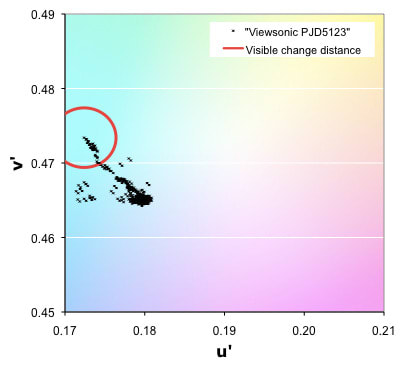
We have decided to display the chart above in addition to the standard color temperature graph below, which doesn't show color drift in the cyan-to-blue direction. The above chart shows the entire range of colors top-down, while the color temperature chart underneath is like looking at the gamut from the side; you won't see changes that don't go from left to right. That's why the color temperature below is so deceptively consistent. For every shade of grey from white to black, we measured its color and made a mark on the color gamut. Most greys read blue, while whites appeared cyan.
Color Temperature
RGB Curves
{{section_header}}{{section.name}}{{/section_header}}
The RGB curves on the PJD5123 were good, but not great. It exhibited some problems displaying transitions, manifest in the color strips below as bands of color. The gradient should look smooth, but it's far from perfect. If all you want to do is show off the sweet gradient you've applied to a bar graph, this projector will do an acceptable job at it.
RGB Curves
Color Gamut
{{section_header}}{{section.name}}{{/section_header}}
The PJD5123 does not exactly adhere diligently to rec. 709 standards. Its white point ends up deep in cyan, and its blue and green points are extremely oversaturated. Blue ends up looking purple. Most televisions oversaturate their colors a little bit, but this is certainly worse than usual. This is not a projector intended for cinema-quality color fidelity.
Color Gamut
Motion Smoothness
{{section_header}}{{section.name}}{{/section_header}}
There was basically no motion processing on the Viewsonic PJD5123. Objects juddered blockily across the screen as though they were pages of a flipbook, if flipbooks also showed objects turning green on one side and purple on the other. Flipbooks don't cause rectangles to shear into parallelograms as they move, either, as this projector did. In conclusion, if motion is your concern, flipbooks might be a budget alternative.
Motion Artifacting
{{section_header}}{{section.name}}{{/section_header}}
When scaled from a 1080p signal instead of the PJD5123's native 800 by 600, the pixels smeared in a way that improved smoothness, but caused problems with artifacts. False coloration still lined the borders of moving objects in purple and green. This stems from the DLP technology and its color wheel, like the "rainbow effect." This projector did not seem to elicit as much rainbow as other DLPs, but if might still cause problems if you're sensitive.
3:2 Pulldown & 24fps
{{section_header}}{{section.name}}{{/section_header}}
Sources encoded at 24 frames per second looked awful on this projector. Apart from an initial strobe, there were no serious processing errors. Moving high-frequency patterns still looked atrocious, though, with crawl and horizontal static. Moving stadium seats, which are usually more forgiving, exhibited crazy, rainbow waves. This is likely due to keystone, resolution, and motion problems, but there is unfortunately no way to say how 3:2 pulldown would look without these issues.
Resolution Scaling
{{section_header}}{{section.name}}{{/section_header}}
Resolution scaling on the PJD5123 was quite bad, due largely to the keystone. Wavy lines of distortion blossomed out from the bottom of the screen and wreaked havoc on high-frequency patterns. Resolution processing was bad to begin with, with some Moiré patterns reduced to a series of vertical lines in 1080p. Sharp lines were blurry in 720p, but 1080p was worse, rife with horizontal, staticky lines. For a budget projector, this one can get the point across, but it can't do much beyond that.
3D Readiness
{{section_header}}{{section.name}}{{/section_header}}
The PJD5123 can do 3D, but you'll need to buy the PGD-250 stereographic 3D glasses to make it work. They're listed for $109 at the time of this review in Viewsonic's shop, here.
Throw
{{section_header}}{{section.name}}{{/section_header}}
The thow (distance between the projector and the screen) on the PJD5123 is relatively inflexible. The distances required for different screen sizes are outlined in the chart below. As you can see, this projector's ability to mediate distance with its 1.1x zoom lens is relatively minor.
Screen Brightness
{{section_header}}{{section.name}}{{/section_header}}
The PJD5123 has a reasonable brightness level, and as a result, is able to project a bright image for even a relatively large screen size. It shouldn't look too washed out, except under the brightest circumstances.
Because of the brightness of the PJD5123, it can project a 140-inch screen with sufficient visibility in a dark setting. As for a bright room, you'll be limited to a 64-inch screen if you want to be able to read it clearly.
Screen Materials
{{section_header}}{{section.name}}{{/section_header}}
If you are forced to give an extemporaneous presentation, you might be at a loss for dedicated projection screens. We throw some text up on various surfaces to simulate this sudden, harrowing event. Even though the PJD5123 offers a few modes intended to give a better picture on black, white, and green boards, we preferred the Brightest setting. From beige walls to wood panels, the brightest image will give you the best legibility.
Optical Issues
{{section_header}}{{section.name}}{{/section_header}}
The PJD5123 has a manual focus ring made of the same cheap plastic as the rest of its casing. It doesn't feel very effective, but maybe that's because "in focus" to this projector is still sort of blurry due to resolution scaling. Pixels aren't surrounded by too much of a flare, but they do stretch into 2, or 4 pixel blocks due to bad scaling and keystone settings. High-frequency patterns have an especially difficult time with keystone distortion. Also, we found purple and green dropshadows subtly highlighting objects from the top and bottom, respectively.
Video Processing
{{section_header}}{{section.name}}{{/section_header}}
The PJD5123 has a few video processing features that are mostly for correcting synchronization from a computer source.
Formats
{{section_header}}{{section.name}}{{/section_header}}
The PJD5123's native resolution is 800 x 600, also known as SVGA. This is yet another indicator that this is a projector intended for classroom and business use, not for home theaters. It can scale to accommodate most other resolutions, but tends to do a poor job of it.
Calibration
{{section_header}}{{section.name}}{{/section_header}}
Calibrating a projector can be a bit tricky because it has so many uses. To this end, Viewsonic provides two User modes that use one of their other presets as a starting point. You could set one of these for bright office-room use, and the other for a more color-accurate theater role. Additionally, lamp settings may be set to Eco to decrease power consumption and, consequently, brightness. The PJD5123's video settings are especially mysterious, because they allow you to set each color on the RGBCMY color wheel separately.
We chose the following calibration settings for color-accuracy in a home theater.
Video Modes
{{section_header}}{{section.name}}{{/section_header}}
There are a handful of video modes from which to choose, or to use as a baseline for one of the user-calibrated modes. Unless you're using them to modify one of these two User modes, these preset video modes may not be changed.
Input Ports
{{section_header}}{{section.name}}{{/section_header}}
The ports on the PJD5123 seem to be dedicated to classroom and office use. Video input ports consist solely of VGA, composite, and the antiquated S-video. The manual instructs you to use component video for the best quality, yet there's not even a component video port. An overly complex diagram in the manual seems to imply you should get an adapter to convert it to VGA. HDMI is not even mentioned.
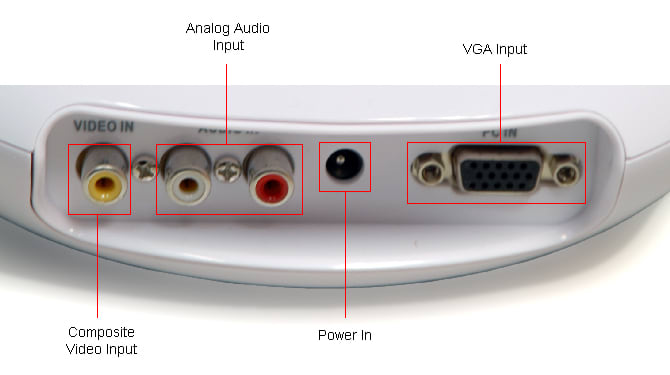
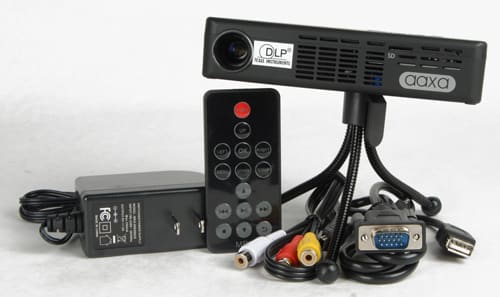
Lots of cables are included
All the ports are listed below.
Other Connections
{{section_header}}{{section.name}}{{/section_header}}
There is a VGA-out port, a micro USB for firmware and mouse support, and an RS-232C port that can be used to remotely control the projector with a computer.
Placement
{{section_header}}{{section.name}}{{/section_header}}
The port configuration is a little strange, but it's well-labeled and not too cramped. Of course, there are so few connectors that it would be difficult for them to feel cramped.
Menus & Manual
{{section_header}}{{section.name}}{{/section_header}}
The PJD5123 comes with a quick-start guide and a CD containing PDF versions of the user manual in several languages. It should answer most of the basic questions you might have, such as how to extract the lamp.
Noise
{{section_header}}{{section.name}}{{/section_header}}
You can expect it to raise the ambient noise of the room by between 9 and 10 decibels in Brightest mode. It's a little bit louder when Eco is on.
{{image_chart title="Noise", attachment="Noise Graph"}}
Heat
{{section_header}}{{section.name}}{{/section_header}}
Projectors generate two things in copious amounts: light and heat. In Brightest mode, the fan kicked out air that was 76.2 degrees (F) higher than the temperature of the room. When Eco was turned on, it only raised the temperature by 67.8˚.
{{image_chart title="Heat", attachment="Heat Graph"}}
Power Consumption
{{section_header}}{{section.name}}{{/section_header}}
Power consumption was relatively inexpensive for a projector, but these are still somewhat costly to maintain. If you use it for five hours a day, you'll spend between $40 and $45 a year on electricity. But what will you gain in presentation knowledge?
Lamp Life
{{section_header}}{{section.name}}{{/section_header}}
The lamp in the Viewsonic PJD5123 is a RLC-072. It promises to last 5000 or 6000 hours, depending on whether you keep it in normal or Eco mode. The current run-time is recorded in the menu, so you can keep tabs on how long it's got to live.
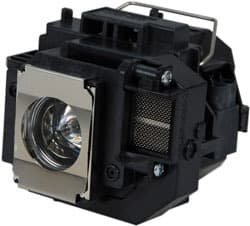
The lamp of the 705HD
Value
{{section_header}}{{section.name}}{{/section_header}}
While the Optoma HD20 is about twice as expensive as the PJD5123, the better value is ultimately going to be decided by whether you're in the market for a home cinema projector or one for office presentations. The Viewsonic is bright enough for a room that's not totally dark, so it could be a good buy in that regard, but its color fidelity is much worse. The HD20 also has the advantage of a native 1080p resolution.
Blacks & Whites
{{section_header}}{{section.name}}{{/section_header}}
The PJD5123 is much brighter, making it a better choice for classroom and office presentations. Its greyscale gamma was phenomenal, so it should do well at this. The Optoma HD20 had better screen uniformity and tunnel contrast, making it a better choice for a home theater.
{{image_chart title="Contrast", attachment="Contrast Graph"}}
Color
{{section_header}}{{section.name}}{{/section_header}}
Color on the Viewsonic PJD5123 is outright laughable. Unless, perhaps, the image being projected is a joke whose punchline is a smooth, color-accurate gradient; in this case, you might be confused and not laugh. In any case, it will suffice for bar graphs and text, but don't expect to be wowed by strong visuals.

Remember that the color temperature chart below is not helpful for the PJD5123. See the chart above for its color drift for every shade of grey, from black to white.
Motion
{{section_header}}{{section.name}}{{/section_header}}
Projectors are bad at motion. That's just how they are. However, the HD20 seems to do a marginally better job at it, which is good, since it's targeted towards the home theater audience.
Viewing Effects
{{section_header}}{{section.name}}{{/section_header}}
The HD20 is a little better in terms of its throw (projector-to-screen distance) flexibility, due to its 1.2x zoom lens. This beats out the PJD5123, whose lens is only 1.1x.
Connectivity
{{section_header}}{{section.name}}{{/section_header}}
Any projector is probably going to have better connectivity than the Viewsonic PJD5123, and the HD20 is no exception. This Optoma has 2 HDMI ports instead of, oh, zero. It also has a component video port instead of the outdated S-video.
Value
{{section_header}}{{section.name}}{{/section_header}}
The Viewsonic is marginally cheaper than the Epson, but it's also marginally dimmer. Since the Epson has similar scores across the board, we'd call the PJD5123 the better buy.
Blacks & Whites
{{section_header}}{{section.name}}{{/section_header}}
The Epson Powerlite 705HD is a little brighter, but the PJD5123 is not so dim that it can't be considered a budget alternative. Unless you're hoping to put on a presentation in an office with light streaming through large windows, the PJD5123 should suffice for most uses. Other black and white results are similar.
{{image_chart title="Contrast", attachment="Contrast Graph"}}
Color
{{section_header}}{{section.name}}{{/section_header}}
Neither of these projectors has any right to claim to be good at color reproduction. They'd might as well squabble over whose father would win in a fight, except that they were coldly ejected into this world by a production line, not parents. The PJD5123's color temperature is so bad, it's zero, while the PowerLite 705HD's RGB curves look like they were crafted from Lego. These are projectors intended for presentations, not video.

Remember that the color temperature chart below is not helpful for the PJD5123. See the chart above for its color drift for every shade of grey, from black to white.
Motion
{{section_header}}{{section.name}}{{/section_header}}
Because the Epson uses 3LCD technology instead of the Viewsonic's DLP, it won't cause that nauseating "rainbow" effect when you turn your head. It has similar motion performance, but better resolution scaling. The major drawback to the Epson PowerLite 705HD is that it doesn't support 24fps inputs. If you planned to watch Blu-ray on this thing, you'd better settle for the Viewsonic PJD5123.
Viewing Effects
{{section_header}}{{section.name}}{{/section_header}}
The Epson PowerLite 705HD's throw was a little more flexible than the PJD5123, and it had fewer optical issues on the level of the pixel. With no rainbow effect, it definitely performs much better in this category. It also has a slightly better 720p resolution.
Connectivity
{{section_header}}{{section.name}}{{/section_header}}
The Epson PowerLite 705HD has much better connectivity with its HDMI port. The PJD5123 has a VGA output, as well as an RS-232C, but neither of these are going to be used nearly as frequently as the current HDMI standard.
Value
{{section_header}}{{section.name}}{{/section_header}}
The PJD6531w costs one or two hundred dollars more than the PJD5123, depending on the seller. Is it worth it? We think so. Because of its higher brightness level, its larger 1280 x 800 native resolution, and its HDMI port, it does everything the PJD5123 can do, only better.
Blacks & Whites
{{section_header}}{{section.name}}{{/section_header}}
Both of these Viewsonics have out-of-this-world greyscale gamma, but the PJD6531w had a much brighter maximum luminance. For large projections or rooms with light, this can be important.
{{image_chart title="Contrast", attachment="Contrast Graph"}}
Color
{{section_header}}{{section.name}}{{/section_header}}
Color performance between these two Viewsonic models was about equally bad. Color temperature was more consistent in the PJD6531w, but its RGB curves and color gamut were slightly worse.

Remember that the color temperature chart below is not helpful for the PJD5123. See the chart above for its color drift for every shade of grey, from black to white.
Motion
{{section_header}}{{section.name}}{{/section_header}}
Motion performance was similar, but better in the PJD6531w. This model performed better in motion and resolution scaling, yet fell behind the PJD5123 in terms of 24fps representation.
Viewing Effects
{{section_header}}{{section.name}}{{/section_header}}
The zoom lens on the PJD6531w offered better flexibility for where you can set the projector in relation to the screen. It also had fewer optical issues, but as another DLP, it might still nauseate you with its rainbow effect.
Connectivity
{{section_header}}{{section.name}}{{/section_header}}
At the cost of an infrequently-used RS-232C port, the PJD6531w has a HDMI and an Ethernet port beyond the PJD5123. These two ports make it the better choice.
Conclusion
With an 800 x 600 native resolution and no HDMI port, the Viewsonic PJD5123 is obviously not meant for home theatrical use. Yet, it can still take a 1080p signal and project it onto your wall. Though it has port limitations and trouble with color fidelity, it's bright enough to show up against a makeshift screen in daylight. For this reason, it could be a great presentation-use projector for travel. Just make sure you or your audience don't have problems with nausea induced by the DLP "rainbow" effect.
Meet the tester
Jackie Lee is a valued contributor to the Reviewed.com family of sites.
Checking our work.
Our team is here to help you buy the best stuff and love what you own. Our writers, editors, and experts obsess over the products we cover to make sure you're confident and satisfied. Have a different opinion about something we recommend? Email us and we'll compare notes.
Shoot us an email